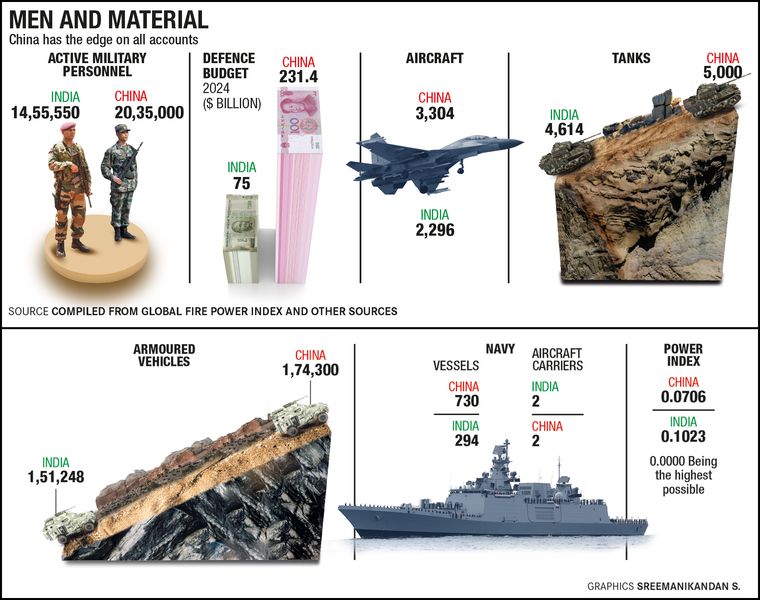The easiest way to compare the defence forces of two countries is to do the bean count of the weapons and equipment that they have. But that gives only one aspect of their capability. The numbers do make up for some strength, particularly when a war of attrition takes its toll on the weapons and equipment of a country. But that alone cannot win wars. If that was the case, the more advanced countries should be winning the wars easily. That has not been the trend. There are many imponderables like training, battle experience, technology absorption, and ability of commanders to clearly read the battle and employ forces that impact the outcome of wars. When comparing the defence forces of India and China, one should consider all these factors.
BATTLE EXPERIENCE
The People’s Liberation Army fought its last war in 1979 against Vietnam. Therefore, many analysts feel that the PLA lacks combat experience. However, my experience of dealing with the PLA on the Line of Actual Control for many years is that the PLA learns fast, and is willing to learn from everybody. It studies the campaigns fought by other countries and takes out lessons for itself. It also tries to train hard.
In contrast, the Indian armed forces are adept in both conventional and counterinsurgency operations. The near normalcy in northeast India and the improving ground situation in Jammu and Kashmir are testimony to that. Similarly, the Kargil War in 1999 proved the mettle of India’s defence forces. India also studies the campaigns being fought by other countries and takes lessons from them. The Indian armed forces are at an advantage in this aspect.
TRAINING
Since the military reforms of 2015-16, PLA’s training for joint operations has increased tremendously. However, President Xi Jinping exhorted the PLA to overcome the “peace disease”. The “two inabilities” (the army’s inability to fight modern wars and the officers’ inability to command) and “five incapables” (some commanders cannot judge situations, understand superiors’ intent, make operational decisions, deploy troops and deal with unexpected situations) cast a shadow on the ability of the PLA.
Post the reforms, Xi started issuing mobilisation orders, from 2018 till 2022, on the new year, and the entire PLA mobilised for a few days to exercise. Party committees at various levels were increasingly becoming involved in assessing the training of units and formations they are associated with. These issues revealed a lack of confidence in the training being carried out by the PLA. All these indicate that the PLA forces have a long way to go in achieving the desired combat efficiency. The PLA trains with very few foreign armies. Mostly, the training missions are with the SCO (Shanghai Cooperation Organisation) countries, except India. It learns about western tactics in its exercises with Pakistan.
In contrast, the Indian armed forces have always proven themselves in all the exercises they have taken part in. However, the reforms that they are trying to implement are getting delayed. For example, theaterisation has been a long time coming. Deliberations on joint operations and training for them have started but there is some distance to go. The Indian armed forces train with many foreign armed forces. Their scale and level are higher. That experience serves them well in absorbing modern techniques in warfare. On the training front, one can say both are equal.
DEFENCE BUDGET
China’s defence budget is three times India’s. Moreover, China produces almost all its weapons and equipment indigenously. This gives it the ability to get more value for money. China’s defence budget is opaque. By some estimates, its actual defence budget is far more than what is announced, as China does not include expenditures on its space and counter-space capabilities and expenditure on research and development. As per the SIPRI (Stockholm Institute of Peace Research) report published in April 2024, China spent $296 billion on defence in 2023. China used to follow the principle of defence budget growing in sync with economic growth. However, for the last few years, China’s defence budget has grown more than the rate of its economic growth. This trend will continue.
India’s defence budget this year is approximately $75 billion as given in the interim budget. It is likely to remain the same in the budget that will be presented by the new government shortly. India has been increasingly resorting to indigenous procurement. A record 75 per cent of capital procurement has been allocated for this purpose in 2023-24. However, India is still dependent on imports for many equipment and spares. This reduces the quantity that it can add to its inventory. India has taken many measures to increase the indigenous production capability and it will take a few years to become fully “atmanirbhar” (self-reliant). In this aspect, China has an advantage, but India is catching up fast.
TECHNOLOGY ABSORPTION
The armed forces that absorb technology will have an upper hand in a war. On April 19, 2024, China dissolved its Strategic Support Force (SSF) and created three independent arms: Aerospace Force, Cyberspace Force and the Information Support Force. Analysts have attributed many reasons for this. I feel that it is the process of adaptability that China has been good at. The SSF was established in 2016. After analysing the shortcomings of that force, China has created three new arms. A reason for that is also the changes the US is making in its forces.
The SSF had invested heavily in AI innovation, leveraging public-private partnerships to gain new technologies for intelligence; surveillance and reconnaissance; autonomous vehicles; information and electronic warfare; simulation and training; predictive maintenance; and target recognition. China has also made advances in robotics, exoskeletons (power armour), swarm drones, hypersonic weapons and unmanned systems. It has made good progress in quantum technologies in the military domain, too.
Also Read
- Can democratic India compete with authoritarian China when it comes to rapid economic development?
- Bilateral diplomacy is a never-ending tightrope walk for India and China
- India must take a leaf out of China's cultural diplomacy and strengthen research on Beijing
- Both India and China use soft power to influence global opinion
- There has never been a better time to pursue a trade deal with China
- China has witnessed a vigorous crushing of civil liberties over the past decade
Not to be left behind, India has declared 2024 as technology absorption year. India has also made advances in exoskeletons, employment of drones and unmanned systems, and has carried out trials on quantum technologies and hypersonic weapons. It can be said that China is ahead of India in this aspect at the moment.
The author is adjunct distinguished fellow, Gateway House, Mumbai and adjunct professor, National Institute of Advanced Studies, Bengaluru.




